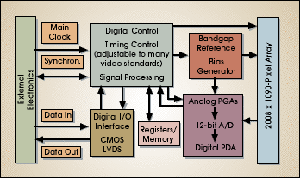
CMOS Technology Addresses Security Imaging Issues
Douglas E. Howe
With increasing global demand for stringent security precautions, the need for high-performance, reliable and cost-effective cameras in both the public and private sectors is on the rise. High-definition video is the new benchmark for video quality, displaying clearer and sharper images with more detailed information and accuracy than ever before.
Until now, the security industry --and camera manufacturers in particular -- largely relied on CCD imagers to meet visual imaging needs. Now, however, imaging advances offered by CMOS sensors, such as high performance, low power consumption and low cost in a compact system, are accessible to this industry, as well as to the professional video, high-definition TV and digital broadcasting industries.
Recently launched high-definition CMOS sensors integrate on the sensor itself several functions that are important for security applications, instead of requiring multiple chips as is the case with CCDs. Their capabilities include data rates up to 75 MHz, 2.1-megapixel resolution and high sensitivity (56-dB signal-to-noise ratio) at very low noise (<20 e–) and power consumption (180 mW). These enable manufacturers to design cameras in unobtrusive housings with low heat buildup in a networked setting, while capturing clear, accurate black-and-white or color images on demand in diverse lighting conditions.

A CMOS HDTV imaging sensor on a chip (Rockwell's ProCamHD 3530) can tightly integrate an active pixel array, a 12-bit analog-to-digital converter and a programmable processor for timing and signal processing. It can generate timing internally (master mode) or can be synchronized with an external source (slave mode).
Performance now can equal or surpass that of CCD technology in several parameters. High-definition CMOS technology can offer a 20 percent improvement in sensitivity, as well as a fivefold improvement in noise reduction and a tenfold reduction in power consumption at high resolution and data rates, without line mixing.
Credit goes to advances in noise-reduction techniques, microlens design and mixed-signal processing. Rockwell Scientific Co.'s "tapered reset" technique, for example, reduces noise while simplifying pixel electronics to maintain high fill factor (the percentage of the pixel that is sensitive to light) for high sensitivity. Microlens technology helps focus more incoming light on the photosensitive area of the pixel, again improving fill factor and pixel performance.
Optimization of analog-to-digital signal conversion also reduces noise, while still enabling high-resolution data throughput. Where CCD progressive rates may reach 24 fps, CMOS sensor-on-a-chip technology can offer 30 fps progressive and 60 fps interlaced. Emerging devices will soon boost this to 60 fps progressive and 120 interlaced.
Because on-chip integration is a hallmark of the technology, the footprint of the electronics is more compact and allows smaller, more unobtrusive camera designs. In addition, higher resolution and adoption of the HDTV 16:9 format enable digital solutions such as pan, tilt and zoom to supplant more costly mechanical components.
In line with these demands, HDTV CMOS image sensors are designed specifically for video capture in these imaging environments. Examples include 1920 X 1080-pixel and 1280 X 720-pixel imagers in industry-standard optical formats. These sensors are optimized to provide high optical fill factor for high sensitivity even at small pixel pitches, as well as high dynamic range and low noise.
Such enhancements make the largest contribution to boosting image quality. Combined with traditional features such as on-chip integration, these enable CMOS technology to meet key challenges to the security industry head-on.
/Buyers_Guide/Rockwell_Scientific_See_Teledyne_Technologies/c12833